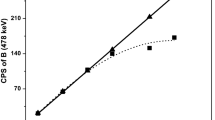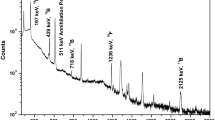Abstract
The prompt gamma activation analysis (PGAA) is an elemental analysis based on the γ-ray emission following neutron radiative capture by nuclides. A simplified and compact PGAA for the determination of boron in borated concrete was setup at the HOTNES neutron facility, relying on common laboratory equipment. The thermal neutron field has fluence rate of about 20 cm−2 s−1 and is obtained from a moderated americium-boron neutron source. The γ-ray detector is a common 3″ × 3″ NaI(Tl) scintillator. Samples of borated resin with the same geometry of the concrete samples were manufactured and used as standards. A specific “blank sample” correction was developed to isolate the boron contribution in the spectra obtained by irradiating the concrete samples. Boron quantities in the order of 1.5–2.0 g were measured in the concrete samples with uncertainty in the order of ± 6%, in agreement with manufacturer's expectations. The Detection Limit of this simplified and compact boron analysis is in the order of 0.3 g in terms of boron mass, in line with values given in literature for PGAA-based boron analysis performed at research fission reactors.






Similar content being viewed by others
Data Availability Statement
This manuscript has associated data in a data repository. [Authors’ comment: He data sets generated during and/or analyzed during the current study are available from the corresponding author on reasonable request.]
References
G.L. Molnàr, Handbook of Prompt Gamma Activation Analysis (Springer, New York, NY, 2004)
F. Baechler et al., Nucl. Instr. Meth. A 488, 410 (2002)
T. Kobayashi, K. Kanda, Nucl. Instr. Meth. 204, 525 (1983)
M. Crittin, J. Jolie, J. Kern, S.J. Mannanal, R. Schwarzbach, B. Larsson et al. (eds.), Advances in Neutron Capture Therapy (Elsevier, Amsterdam, 1996), p.343
S. Sollradl et al., J. Radioanal. Nucl. Chem. 298, 2069 (2013)
L.A. Currie, Appl. Radiochem. Anal. Chem. 40, 586 (1968)
J.A. Robinson, M.R. Hartman, S.R. Seese, J. Radioanal. Nucl. Chem. 283, 359 (2010)
E.A. Mackey et al., Nucl. Instr. Meth. B 226, 426 (2004)
S.H. Byun, G.M. Sun, H.D. Choi, Nucl. Instrum. Meth. B 213, 535 (2004)
D.D. DiJulio et al., Nucl. Instr. Meth. A 859, 41 (2017)
E. Gallego et al., Nucl. Technol. 168, 399 (2009)
D.I. Tishkevich et al., RSC Adv. 13, 24491 (2023)
D.A. Aloraini et al., Opt. Mater. 121, 111589 (2021)
D.I. Tishkevich et al., Nanomaterials 12, 1642 (2022)
A.V. Trukhanov et al., Ceram. Int. 45, 15412 (2019)
M.T. Alabsy et al., Materials 14, 5051 (2021)
D.I. Tishkevich et al., IOP Conf. Ser. Mater. Sci. Eng. 848, 012089 (2020)
S. Pospı́šil et al., Nucl. Instr. Meth. A 420, 249 (1999)
M. Dong et al., J. Clean. Prod. 355, 131817 (2022)
A. Sperduti et al., JINST 12, P12029 (2017)
R. Bedogni et al., Nucl. Instr. Meth. A 843, 18 (2017)
R. Bedogni et al., Appl. Radiat. Isot. 127, 68 (2017)
Tecnostrutture S.r.l. website. https://www.tecnostrutture.eu/
C.J. Werner (ed.), MCNP Users’ Manual-Code Version 6.2 (Los Alamos National Laboratory, Los Alamos, USA, 2017)
A. Pietropaolo et al., Eur. Phys. J. Plus 136, 1140 (2021)
G.M. Contessa et al., Environments 9, 71 (2022)
P. Ferrari et al., Eur. Phys. J. Plus 138, 435 (2023)
Author information
Authors and Affiliations
Corresponding author
Rights and permissions
Springer Nature or its licensor (e.g. a society or other partner) holds exclusive rights to this article under a publishing agreement with the author(s) or other rightsholder(s); author self-archiving of the accepted manuscript version of this article is solely governed by the terms of such publishing agreement and applicable law.
About this article
Cite this article
Pietropaolo, A., Russo, L., Calamida, A. et al. Determination of boron in borated concrete by means of a simplified prompt gamma activation analysis at the HOTNES facility. Eur. Phys. J. Plus 138, 1114 (2023). https://doi.org/10.1140/epjp/s13360-023-04752-1
Received:
Accepted:
Published:
DOI: https://doi.org/10.1140/epjp/s13360-023-04752-1




